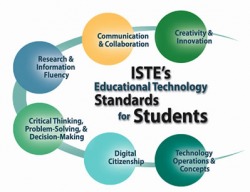Learning Standards
New York State Content Area Standards
- Languages Other Than English Standard #1: Students will be able to use a language other than English for communication. (Lessons #1, 2, 3, 4)
- Languages Other Than English Standard #2: Students will develop cross-cultural skills and understandings. (Lesson #4)
ISTE NETS for Students
1. Creativity and Innovation (Lesson #4)
Students demonstrate creative thinking, construct knowledge, and develop innovative products and processes using technology. Students:
a. apply existing knowledge to generate new ideas, products, or processes.
b. create original works as a means of personal or group expression.
2. Communication and Collaboration (Lesson #4)
Students use digital media and environments to communicate and work collaboratively, including at a distance, to support individual learning and contribute to the learning of others. Students:
a. interact, collaborate, and publish with peers, experts, or others employing a variety of digital environments and media.
b. communicate information and ideas effectively to multiple audiences using a variety of media and formats.
d. contribute to project teams to produce original works or solve problems.
3. Research and Information Fluency (Lessons #1, 2, 3, 4)
Students apply digital tools to gather, evaluate, and use information. Students:
a. plan strategies to guide inquiry.
b. locate, organize, analyze, evaluate, synthesize, and ethically use information from a variety of sources and media.
c. evaluate and select information sources and digital tools based on the appropriateness to specific tasks.
d. process data and report results.
4. Critical Thinking, Problem Solving, and Decision Making (Lesson #4)
Students use critical thinking skills to plan and conduct research, manage projects, solve problems, and make informed decisions using appropriate digital tools and resources. Students:
b. plan and manage activities to develop a solution or complete a project.
c. collect and analyze data to identify solutions and/or make informed decisions.
5. Digital Citizenship (Lessons #1, 2, 3, 4)
Students understand human, cultural, and societal issues related to technology and practice legal and ethical behavior. Students:
a. advocate and practice safe, legal, and responsible use of information and technology.
b. exhibit a positive attitude toward using technology that supports collaboration, learning, and productivity.
6. Technology Operations and Concepts (Lessons #1, 2, 3, 4)
Students demonstrate a sound understanding of technology concepts, systems, and operations. Students:
a. understand and use technology systems.
b. select and use applications effectively and productively.
Students demonstrate creative thinking, construct knowledge, and develop innovative products and processes using technology. Students:
a. apply existing knowledge to generate new ideas, products, or processes.
b. create original works as a means of personal or group expression.
2. Communication and Collaboration (Lesson #4)
Students use digital media and environments to communicate and work collaboratively, including at a distance, to support individual learning and contribute to the learning of others. Students:
a. interact, collaborate, and publish with peers, experts, or others employing a variety of digital environments and media.
b. communicate information and ideas effectively to multiple audiences using a variety of media and formats.
d. contribute to project teams to produce original works or solve problems.
3. Research and Information Fluency (Lessons #1, 2, 3, 4)
Students apply digital tools to gather, evaluate, and use information. Students:
a. plan strategies to guide inquiry.
b. locate, organize, analyze, evaluate, synthesize, and ethically use information from a variety of sources and media.
c. evaluate and select information sources and digital tools based on the appropriateness to specific tasks.
d. process data and report results.
4. Critical Thinking, Problem Solving, and Decision Making (Lesson #4)
Students use critical thinking skills to plan and conduct research, manage projects, solve problems, and make informed decisions using appropriate digital tools and resources. Students:
b. plan and manage activities to develop a solution or complete a project.
c. collect and analyze data to identify solutions and/or make informed decisions.
5. Digital Citizenship (Lessons #1, 2, 3, 4)
Students understand human, cultural, and societal issues related to technology and practice legal and ethical behavior. Students:
a. advocate and practice safe, legal, and responsible use of information and technology.
b. exhibit a positive attitude toward using technology that supports collaboration, learning, and productivity.
6. Technology Operations and Concepts (Lessons #1, 2, 3, 4)
Students demonstrate a sound understanding of technology concepts, systems, and operations. Students:
a. understand and use technology systems.
b. select and use applications effectively and productively.

